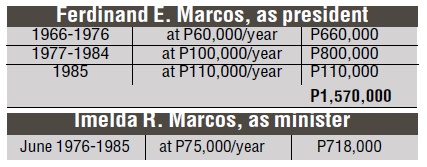‘Skeletons of their kleptocracy’
The Disaster that occurred on Sept. 11, 2001 (9/11), in the United States—four coordinated attacks in Washington, DC and New York City—killed 2,996 people, injured 6,000 others, and cost at least $10 billion in infrastructure and property damage. *
One could also talk about another Sept. 11, this time in 1917, when the dictator Ferdinand Marcos was born, and there have been attempts to estimate the cost of the death and destruction during the martial law years that he imposed on this country.
If he had died in 1942, as a soldier who fell in Bataan, or if he had died after his second term as president of the Philippines, there would have been little or no controversy about him, and he would have earned a place in the Libingan ng Mga Bayani with no questions asked.
But he placed the Philippines under martial law during the last years of his presidency, and made himself dictator for the next 14 years. It is what he did as dictator, and what he did as a soldier after Bataan, that completely wash away whatever accomplishments he could have claimed. That the present administration chooses to close its eyes to these “bads,” as if they never happened, is what is causing all this controversy now.
The fact is that Marcos was a kleptocrat—“a ruler who uses political power to steal his country’s resources.” And he stole big-time, being listed as No. 2 (to Suharto) among the 10 most corrupt leaders in modern history.
But lest I be accused of hyperbole, let’s borrow the arithmetic computations that were used by the Supreme Court in the matter (GR 189434), courtesy of the Republic of the Philippines. But first, this is the law (Republic Act No. 1379): “Whenever any public officer or employee has acquired during his incumbency an amount of property which is manifestly out of proportion to his salary as such public officer or employee and to his other lawful income and the income from legitimately acquired property, said property shall be presumed prima facie to have been unlawfully acquired.”
It seems that the combined salaries of Ferdinand E. Marcos as president and Imelda R. Marcos as minister for the years 1966-1986 amounted to a grand total of P2,319,583.33, broken down as follows:
Add to these their combined salaries for January and February 1986 of P30,833.33, and you get the P2.3 million total in the table, which when converted to US dollars on the basis of the prevailing exchange rates in that period, would then have the equivalent value of $304,372.43. For 20 years.
Note, Reader, that Marcos’ starting salary was P5,000 a month until 1976, then it went up to P8,333 from 1984, and then further up to P9,166 a month until he was removed (by revolution) by the Filipino people in February 1986.
An interesting sidelight was that the Marcoses submitted that their income from 1965 to 1984 amounted to P16,408,442.00, including P11+ million in legal practice fees, and P2.5l+ million from “Others.” There was only one problem: The president is barred by law from practicing during his entire presidency, so legal practice (with P11 million) was out. Were they receivables from before he became president? Again, the problem was that in his 1965 income tax return, Marcos failed to show that he had any receivables from any client at all. In fact, his declared net worth as of December 1965 was all of P120,000.00. Small potatoes.
The Marcos spouses also declared that their net worth in 1984 amounted to $957,487.75. Naturally, the Supreme Court compared this with their combined salaries of $304, 372.43 and came to the inevitable conclusion: The Marcoses could explain less than one-third of their wealth. And that wealth didn’t even include Swiss deposits and the like.
What Swiss deposits and the like? Well, there was an Arelma account, which in 1983 was worth $3,369,975. The lawful income of the Marcoses during their entire incumbency represents only 9 percent of that. What about the five other Swiss accounts? Well, as of 2002, these amounted to over $658 million. Did I forget to mention paintings, and jewelry worth a king’s ransom, and property in New York? Count those in, too.
And the Filipino people are the real losers. They not only have to pay for what was stolen, they now, it seems, have to say that these people are to be honored for stealing from them.
Clearly, these public officers, Marcos and his wife, were kleptocrats. That was the term used by the solicitor general (obviously not the incumbent), as in: “The joint returns of FM and Imelda cannot, therefore, conceal the skeletons of their kleptocracy.”
Now, my question is: Why does one solicitor general call Marcos a kleptocrat, stealing from the Filipino people, and another solicitor general call him a hero? And defend his right to be buried in the Libingan ng Mga Bayani? Doesn’t the office have any institutional memory? Will the real defender of the Republic of the Philippines please stand up?
















